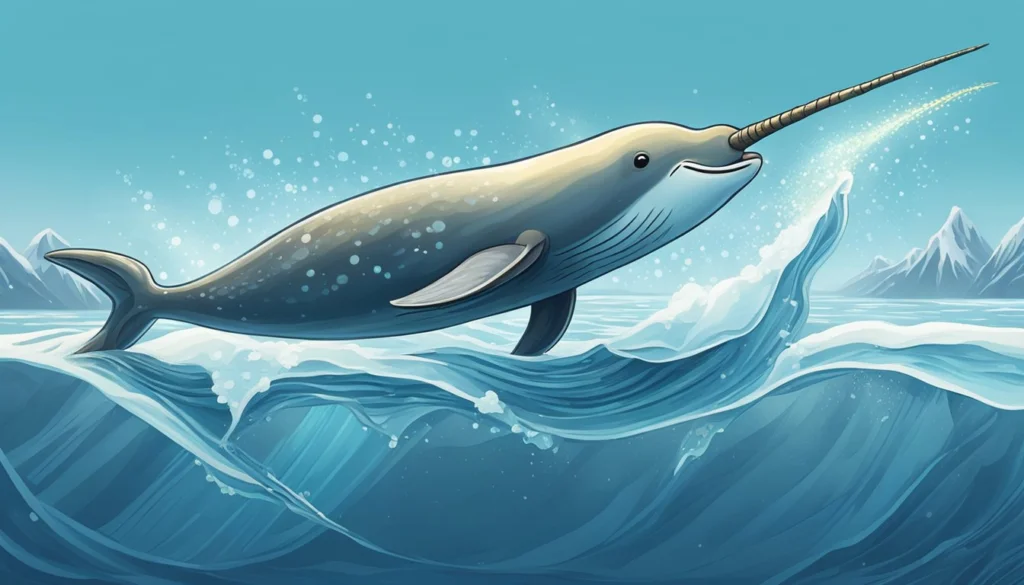The Narwhal (Monodon monoceros) is one of the ocean’s most mysterious and captivating creatures. Known for its long, spiral tusk, often likened to the horn of a unicorn, the narwhal has fascinated people for centuries. Found in the Arctic waters of Canada, Greenland, Norway, and Russia, narwhals have adapted to survive in one of the harshest environments on Earth. Let’s dive into the most incredible facts about this elusive marine mammal.
1. The Narwhal’s Tusk is a Tooth
The most striking feature of the narwhal is its long, spiral tusk, which can grow up to 10 feet (3 meters) long. What many people don’t realize is that this tusk is actually an overgrown tooth. Male narwhals typically have one elongated tooth, although about 15% of females also grow a tusk.
The tusk grows out of the left side of the upper jaw, spiraling counterclockwise. It is made of ivory, similar to the tusks of elephants and walruses, and is extremely sensitive. Scientists believe the tusk has thousands of nerve endings, allowing the narwhal to sense changes in its environment, such as water temperature, salinity, and pressure.
Key Facts:
- Length: Up to 10 feet (3 meters).
- A Tooth: The tusk is a modified tooth made of ivory.
- Sensory Organ: Contains thousands of nerve endings for environmental sensing.
2. Only Males Typically Have Tusks
While male narwhals are most famous for their tusks, not all narwhals have them. The tusk is predominantly a feature of male narwhals, and only a small percentage of females develop them. The reason behind this sexual dimorphism is not entirely understood, but researchers believe the tusk may be used by males to impress females or assert dominance during mating season.
In some rare cases, narwhals can grow two tusks if both teeth grow, though this is an uncommon phenomenon. The role of the tusk in mating and social interactions is still an area of ongoing research.
Tusk Gender Differences:
- Males: Almost all male narwhals grow a tusk.
- Females: Only about 15% of females develop a tusk.
- Two Tusks: Rare cases of narwhals growing two tusks have been observed.
3. Narwhals Are Expert Divers
Narwhals are known for their incredible diving abilities. These Arctic whales can dive to depths of over 5,000 feet (1,500 meters) in search of food, making them some of the deepest-diving marine mammals on the planet. They can stay underwater for up to 25 minutes before needing to resurface for air.
Their primary prey includes Greenland halibut, Arctic cod, and squid, which they catch during these deep dives. Narwhals have adapted to the cold, dark waters of the Arctic with specialized features such as the ability to slow their heart rate to conserve oxygen during deep dives.
Diving Capabilities:
- Depths: Can dive over 5,000 feet (1,500 meters).
- Duration: Can stay submerged for up to 25 minutes.
- Prey: Feed on halibut, cod, and squid during deep dives.
4. Masters of the Arctic Environment
Narwhals are uniquely adapted to life in the Arctic Ocean, where they thrive in the icy waters. Unlike many other marine mammals that migrate to warmer waters, narwhals spend their entire lives in the Arctic. During winter, they live under the sea ice, using cracks and openings in the ice to breathe.
Narwhals have a thick layer of blubber that insulates them from the frigid temperatures, and they rely on sea ice for protection from predators like orcas. As the climate changes and Arctic sea ice declines, narwhals face growing challenges to their survival, as their icy habitat is rapidly disappearing.
Arctic Adaptations:
- Arctic Residents: Narwhals live year-round in the Arctic.
- Blubber: Thick blubber layer provides insulation from the cold.
- Sea Ice: Use cracks in the ice to breathe during winter months.
5. Narwhals Communicate with Clicks and Whistles
Narwhals are highly social animals and use a variety of vocalizations to communicate with each other. These vocalizations include clicks, whistles, and pulses, which are used for navigation, hunting, and social interaction. Like other toothed whales, narwhals use echolocation to find prey in the dark, murky waters of the Arctic.
The sound waves emitted by narwhals bounce off objects in the water, helping them determine the location and distance of prey, obstacles, or other whales. Each narwhal has its own unique set of vocalizations, which are thought to help maintain group cohesion within pods.
Communication:
- Vocalizations: Clicks, whistles, and pulses.
- Echolocation: Used for hunting and navigation.
- Social Interaction: Each narwhal has unique sounds for communication.
6. Narwhals Live in Pods
Narwhals are social creatures and are often seen swimming in pods, which can range in size from a few individuals to large groups of over 20. During the summer months, pods can merge into superpods of several hundred narwhals as they migrate to their summer feeding grounds.
These pods are often made up of family groups, and narwhals rely on each other for protection and guidance. Narwhal pods are known to be cooperative, and they often move in unison, using their group strength to avoid predators and navigate the ice-filled waters of the Arctic.
Social Structure:
- Pods: Typically consist of 5-20 narwhals.
- Superpods: Larger gatherings of hundreds of narwhals during migration.
- Family Groups: Pods often consist of related individuals.
7. Climate Change Poses a Threat
Narwhals are considered one of the species most vulnerable to climate change. As the Arctic warms and sea ice declines, the narwhal’s habitat is shrinking. These whales depend on stable sea ice for protection from predators and for access to breathing holes. As the ice melts earlier each year, narwhals are exposed to greater predation from orcas and habitat disruption.
Additionally, as shipping lanes in the Arctic open due to melting ice, the increase in human activity, noise pollution, and potential oil spills pose new threats to narwhals, whose sensitive hearing is essential for navigation and hunting.
Threats from Climate Change:
- Melting Sea Ice: Loss of habitat threatens their survival.
- Increased Predation: Orcas have more access to narwhals as ice disappears.
- Human Activity: Rising noise pollution and shipping traffic in the Arctic.
8. Cultural Importance to Indigenous Peoples
Narwhals have long been important to the Inuit and other Indigenous peoples of the Arctic, who have traditionally relied on them for food and materials. Narwhal meat is an important source of sustenance, and their blubber, called muktuk, is rich in nutrients like vitamin C. Narwhal tusks are also used in art and tools.
The relationship between narwhals and Indigenous peoples is one of respect and sustainability, with traditional knowledge playing a key role in conservation efforts to protect the species while maintaining cultural practices.
Cultural Significance:
- Inuit Use: Narwhal meat and blubber are important for sustenance.
- Tusk Use: Tusk ivory is used in tools and artwork.
- Sustainable Hunting: Indigenous communities practice sustainable hunting to preserve narwhal populations.
9. Narwhals Can Live Up to 50 Years
Narwhals have a relatively long lifespan, with individuals living up to 50 years in the wild. Like other long-lived marine mammals, narwhals experience a slow rate of reproduction, with females giving birth to a single calf every three years after a gestation period of about 14 months.
Calves are nursed by their mothers for up to two years before becoming independent. The long lifespan and slow reproductive rate make narwhals particularly vulnerable to population declines, as it can take many years for populations to recover from disturbances or threats.
Lifespan and Reproduction:
- Lifespan: Narwhals can live up to 50 years.
- Reproductive Rate: Females give birth to a single calf every three years.
- Calf Rearing: Mothers nurse their calves for up to two years.
10. The Tusk’s True Purpose is Still a Mystery
Despite years of research, the true purpose of the narwhal’s tusk remains something of a mystery. While early theories suggested it was used for breaking ice or spearing fish, recent studies indicate that the tusk may be a sensory organ, allowing narwhals to detect changes in their environment. The tusk’s thousands of nerve endings are sensitive to temperature, salinity, and pressure changes, which may help narwhals navigate their Arctic habitat.
Other theories suggest the tusk is used in mating displays, with males competing by displaying their tusks to impress females or assert dominance. However, more research is needed to fully understand the function of this extraordinary feature.
Tusk Theories:
- Sensory Organ: Detects environmental changes such as temperature and salinity.
- Mating Display: Used by males to compete for mates.
- Ongoing Mystery: The true purpose of the tusk remains unclear.
Conclusion
The narwhal is one of the most remarkable creatures of the Arctic, known for its elusive nature, impressive tusk, and expert diving abilities. As a species deeply connected to its icy habitat, the narwhal faces significant challenges from climate change, but ongoing conservation efforts and Indigenous knowledge offer hope for its future. Whether admired for its mysterious tusk or its role in the Arctic ecosystem, the narwhal remains one of the most iconic and incredible marine mammals on the planet.
FAQ
Why do narwhals have tusks?
The narwhal’s tusk is an elongated tooth, and while its exact purpose is still debated, it may serve as a sensory organ or a tool for males to compete for mates.
How deep can narwhals dive?
Narwhals can dive to depths of over 5,000 feet (1,500 meters), making them some of the deepest-diving marine mammals.
Are narwhals endangered?
While narwhals are not currently classified as endangered, they are considered vulnerable due to the threats posed by climate change and habitat loss.
What do narwhals eat?
Narwhals primarily feed on Greenland halibut, Arctic cod, squid, and other fish species during their deep dives.
How long do narwhals live?
Narwhals can live up to 50 years in the wild.
Do female narwhals have tusks?
While it is more common for males to have tusks, about 15% of female narwhals also develop a tusk.


